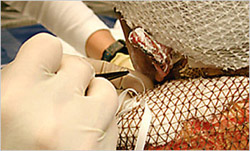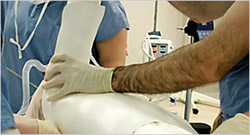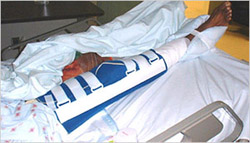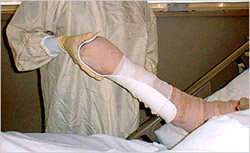The adjunctive use of bolsters
and splints help achieve intimate contact with the wound
bed and immobilize graft sites. They should be initially
applied in the OR. The specific needs of the patient should
be assessed before applying a bolster or splint. Bolsters
provide padding in concave areas, enhancing intimate contact
between INTEGRA® Template and the wound bed.
Splinting aids in keeping the INTEGRA® Template site in a fixed position, particularly when the
matrix
is applied across a joint. The length of time a patient
remains in a splint varies; splints should only
be removed for dressing changes and physical therapy.
The care of your patient should include consultation with
the physical therapist, who may be able to suggest alternative
measures for
addressing specific bolstering and splinting needs. Finally,
it is important to assess and medicate
to the pain threshold of patients during this process.
In an axilla,
a bolster
is applied under an elastic net layer that is then
secured by tying. Tying the elastic net allows for
the bolster to
be easily changed during routine examination. |
 |
| In this picture the
patient has a knee immobilizer,
with the knee strap removed. The knee immobilizer
can be used on the lower extremities for approximately
one week. Care should be taken to reduce or eliminate
the pressure across the kneecap. |
 |
| Thermoplastic
splints are often applied in the OR to immobilize
the patient following surgery |
 |
| This patient is having
a paddle splint applied,
assisting in the physical therapy of the arms |
 |